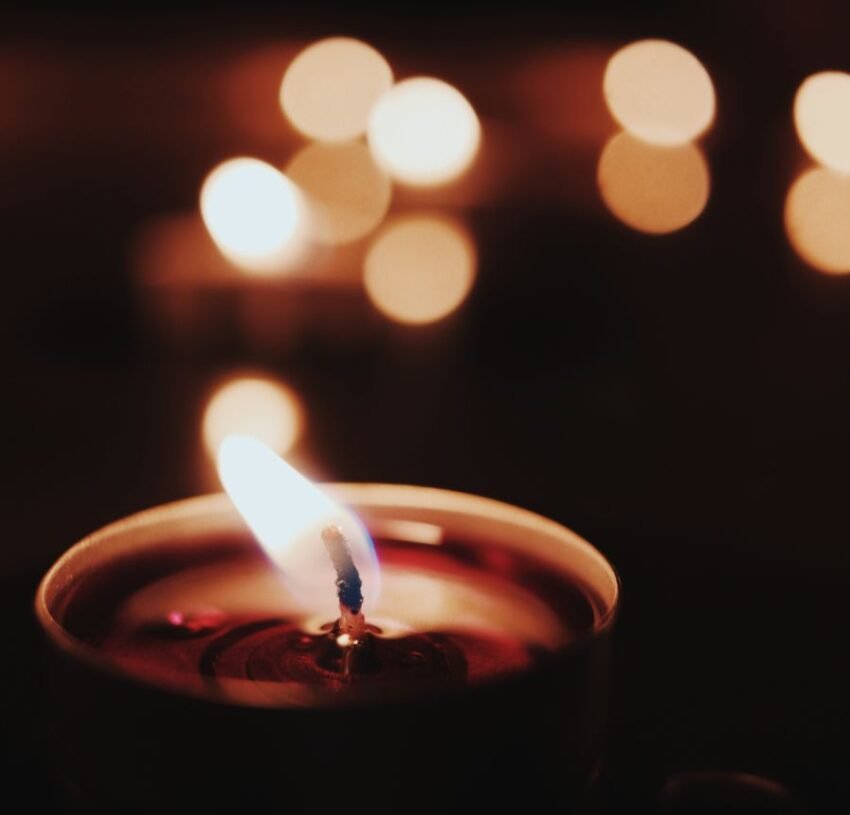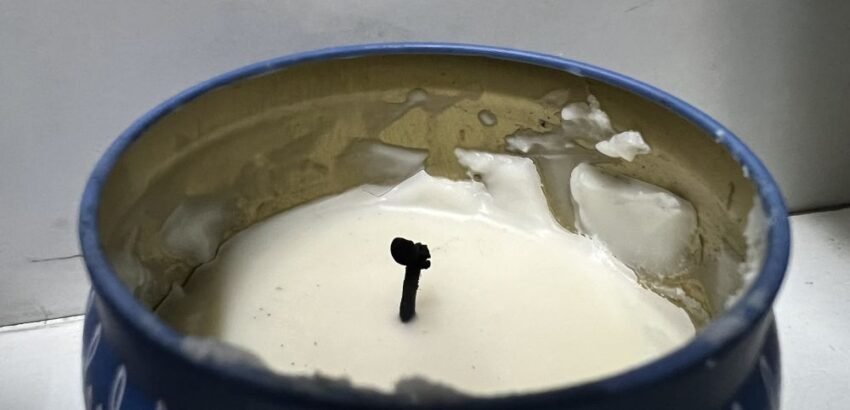Being in the presence of an exploding candle can be nerve-wracking. Mostly, we light a candle to feel better and relax. An exploded candle is the antithesis of that expectation! Yet, accidents do happen and it’s better to stay informed, rather than being caught off-guard.
Staying informed also means that you can stave off this problem, should it arise. While events like these are rare, they can happen. I’ve witnessed it once and wondered why my glass candle exploded.
I mention glass specifically for exploding candles because most modern candles utilize glass containers. Other containers, like metal tins, for example, are unlikely to have the same problem.
Let’s get on with the details.
Can Candles Explode? And What It Means
First off, let’s get a better understanding of exploding candles and what it really means. The phrase “exploding candles” is commonly used, but it’s not necessarily a good fit.
The words exploding candles can evoke the movie-style imagery of a huge bang and flaming materials flying everywhere.
In reality, noise may not necessarily accompany an exploding candle. The cause of the noise is the cracking of the glass container. As the glass cracks, it may give off a loud noise. In some cases, the noise will be subdued though the glass will fall off.
Sometimes, as the glass breaks, it might also give way to some molten wax to splatter. If it lands on a person, this wax can cause injury. However, a more dangerous problem is that the wax may reach its flash point as one of the causes of exploded candles.
In this scenario, the candle becomes a serious fire hazard and it’s important to contain the fire first. If the wax starts burning, don’t try to blow it out with air, and don’t douse it with water. As with grease fire, throwing water on a wax fire will make things much worse and very dangerous.
It’s best to use a proper fire extinguisher or to smother the flame.
There’s a very interesting Twitter thread where famous author J.K. Rowling experienced an exploding candle. Though this thread is several years old, it can serve as a good example of candle explosions.
To sum up, yes, candles can explode. In some cases, it’s just the candle jar cracking. In others, it might be more serious with the wax splattering or wax catching on fire.
Why Do Candles Explode? The Causes And Likely Scenarios
There can be a number of reasons why a candle exploded. Let’s get a better understanding of why candles explode by understanding the events that may have caused this problem.
1. Burning A Candle For Too Long May Weaken The Jar
Most candle makers recommend three-four hours as the maximum burning time for glass jar candles. It’s worth noting that glass is a fairly sturdy material for candles. However, the exposure to heat from the candle will heat it up significantly.
With a burning candle, the glass jar absorbs some heat from the flame. Additionally, the wax too keeps getting hotter the longer the candle burns. As such, the glass jar has to contend with another source of heat.
The longer this goes on, the hotter the glass jar gets. Eventually, the glass can reach a breaking point.
In many candles, the longer the candle stays on, the deeper the wax pool gets. As the wax pool deepens, the wick loses its support to stay in position. This can cause the wick to bend, thus putting greater heat on one side of the candle.
This can cause the glass to crack or break. As this happens, the hot molten wax in the candle will leak out. In some cases, it might splatter, increasing the risk of injuries or property damage.
2. Wax Reaching Its Flash Point
When candles burn for too long, it’s not just the glass that we have to worry about. The wax too keeps getting hotter. Eventually, the wax might get hot enough to reach its flashing point.
If this happens, the wax itself catches fire. This will quickly heat the glass container, increasing the possibility of the container breaking and causing a candle explosion.
Wax fires can be scary and tough to handle. But remember to stay level-headed and make good choices. To reiterate a point that’s been previously mentioned, never throw water on a wax fire. It will cause the burning wax to splatter, exponentially increasing the risk of injury and damage.
The best bet in this scenario is to suffocate the flame.
The temperature at which the wax can catch fire is called the flash point. This temperature varies for different types of wax. For paraffin wax, the flash point is 390°F to 464°F (199°C to 240°C).
The flash point of other popular waxes, like soy wax, palm wax, etc. can vary depending on the blend used or the manufacturing process. Additionally, candles may contain dyes, fragrance oils, or other additives that alter the flash point of the wax.
3. Wick Management Of The Candle

Generally, it is recommended that you trim the wick before lighting the candle. Ideally, the wick should be ¼ inch in length when lit. Large wicks tend to expand and accumulate carbon. This leads to irregular burning and flames, which may deform the candle.
Large wicks with soot and carbon accumulation may also cause other problems, like overheating the wax, which in turn can cause the candle to pop or explode.
4. Burning A Candle In A Cracked Jar
Imagine a scenario where someone buys a lovely scented candle in a jar. These candles tend to be expensive. So, imagine the disappointment when it’s time to light the candle and a crack in the jar becomes apparent.
Many people would prefer not to throw away such an expensive candle. However, as we discussed in a previous article, burning a candle with a cracked jar is not a good idea. The heat may cause the molten wax to flow towards and out of the cracks.
The increased pressure can cause the already fragile jar to break, causing the candle to pop.
5. Water Splashing Into The Candle
What’s a good idea for a nice and relaxing bath? Well, many people prefer to place jar candles around the bathtub or somewhere close. This sets a nice ambiance, brings fragrance, and looks very pretty.
Most of the time, this will go off without a hitch, though there is a risk. As we already know, candle wax and water don’t mix well. Even a small amount of water hitting a hot wax pool can be dangerous.
It can cause the molten wax to splatter, which can cause damage or injury. This event can have unpredictable outcomes. The sudden change in temperature with the introduction of water can cause the candle glass container to crack while the wax pool splatters. Old-school candles without a jar can be a superior choice in this scenario, though not free of risks.

It’s worth pointing out that this is a rare scenario, as far as the risk of a candle exploding is concerned. A candle will not kamikaze itself at the sight of a bathroom. Yet, given the moisture-rich environment, it makes sense to practice some care.
While many people light candles in the bathroom, I’ll suggest keeping them on a stable surface, away from the bathtub. Also, don’t store candles in the bathroom. The moisture-rich environment can have a negative impact on the quality of the candle.
6. Using A Plate Candle Warmer With A Large Candle
This specific instance doesn’t concern the conventional way of using a scented candle. In this case, I’ll talk about using a candle warmer, or more specifically, a plate warmer style candle warmer.
The way these candle warmers work is that the plate gets hot and heats the candle placed on it. Eventually, the entire wax in the candle heats and melts, giving off its fragrance.
Most plate-style candle warmers work well with candles from 4-12 oz in volume. The numbers can vary and it’s best to check with the manufacturer’s documentation.
Putting a candle larger than the expected volume can cause a problem. For example, a 25 oz glass jar candle on a 12 oz max plate warmer may not fare well.
In this case, the entirety of the candle wax will not melt and the top layer of wax will remain solid. The molten wax at the base of the candle will exert pressure on the top layer of wax as well as the glass jar.
This might result in the glass jar breaking and the molten wax spilling out.
7. Candles Containing Flammable Objects
There is a huge variety of candles available and aesthetics remain as important as the candle. To get a leg up with aesthetics, some candle makers will add additional elements to the candle. These can include flowers, sprinkles, candies, and several other objects.
As we previously discussed in the article on putting sprinkles in candles, adding these objects to a candle is a bad idea. Objects like these can get in contact with the candle flame or be distorted by heat. If they get burnt, they may release a bad smell and smoke. In some cases, the burnt object might release soot that clogs the candle wick.

Flammable objects like flowers or leaves can burst into flames and heat the wax, pushing it to its flash point. They’ll also damage the glass, which eventually results in a candle explosion.
Candles must utilize only candle-safe materials. Good candle makers can do wonders with wax and candle-safe materials. You can get things like sprinkles, flowers, and a lot more made with wax. Many candle makers use molds to achieve these shapes, while others might follow different methods.
Whatever the case, remember aesthetics doesn’t beat safety. Any candle you buy should only have materials that are safe when exposed to a flame. For most candles, this means any aesthetic decorations must be made from wax.
What To Do If A Candle Explodes?
Here’s what you can do if you’ve had a candle explode in your home.
In most cases, this will just be a loud noise and a cracked or broken candle container. The first thing to do here would be to use a candle snuffer to quickly extinguish the wick.
However, in rare events, there might be fire, including times when the wax starts burning. This category is more serious and requires careful handling.
You have to stay level-headed if such an event happens. It can be quite scary, but panicking can make the situation a whole lot worse.
1. Don’t Put Water On Burning Wax Or Exploded Candle
As humans, our first instinct or reaction on seeing a fire is to douse it with water. Though I’ve said it a couple of times in this article already and am at the risk of sounding like a broken record, I’ll say it again. Don’t put water on a wax fire or an exploding candle.
If the wax is past its flash point and has caught fire, adding water will cause it to splatter. Burning wax splattering around you will cause injuries and might start a fire.
Similarly, even if the wax is not on fire, adding water will cause the hot molten wax to splatter. This too can cause injury.
Moral of the story? Don’t put water on burning wax or an exploded candle.
2. Smother The Flame
If you see a fire starting in the candle jar, but the glass container is intact, quickly cover it with the candle lid or something similar and non-flammable. This will cut off the oxygen supply to the fire and it will die out.
In case the candle jar cracks or explodes, but the wax is not on fire, you’ll need to think of putting out the flame. Don’t blow on the candle, this can cause more problems.
Using a candle snuffer would be useful in this scenario. A wick dipper can work too, though it’s not that efficient.
You can get creative with smothering the flame as long as you use only non-flammable materials. For example, putting a suitably-sized stainless steel bowl from the kitchen over the candle can smother the flame effectively.
3. Use A Fire Extinguisher
In case you see that the candle flame is out of control or the candle has exploded, consider using a fire extinguisher. Direct it towards the flame and spray until the candle goes out.
Using a full-size fire extinguisher might be overkill, but don’t shy away from using it if that’s your only option. It might be worthwhile to keep a small fire extinguisher or suppressant at home.
4. Smother It With Baking Soda
Another good option is to use baking soda to smother an exploded candle and its fire. When baking soda comes in contact with heat, it releases carbon dioxide. This cuts off the oxygen supply to the flame, causing the flame to go out.
Don’t go slow. Just heap the baking soda on the flame and watch it go out.
5. Put Dirt Or Sand On It
Dirt, mud, and sand are great at smothering flames. Sand is non-flammable and will quickly smother the fire. This is a quick, easy, and accessible way to quickly put out a flame.
6. Call The Fire Department
In case you’re unsure of what to do or things look like they’re taking a turn for the worst, call the local fire department and warn others at home and neighbors of the problem.
How To Burn A Candle Safely To Prevent Exploding Candles
Simple candle maintenance and proper use go a long way in preventing untoward incidents. While an exploding candle is a rarity, there is no harm in taking preventive steps that ensure your risk of this problem gets considerably reduced, if not completely removed.
Here are some ideas.
1. Trim The Wick
The idle wick length before you light a candle is about a quarter of an inch. You don’t have to be exact, but somewhere nearabout is good enough. When you trim the wick, don’t let the trimmings fall into the candle. Take them out and throw them in the trash.
Using a wick trimmer or clipper can be a good option as these are specialized tools that hold onto the trimmed wick. Of course, you can use the method of your choice.

Trimming the wick also removes the “mushroom”. This is the twisted and burnt bit you often see at the top of the wick. The image here shows the mushroom on a candle wick. Please excuse the unsightly uneven wax around the wick in the image, I was experimenting and testing while burning this candle.
A trimmed wick is unlikely to allow soot build up or to burn uncontrollably. This keeps the flame in check and reduces chances of accidents.
2. Watch The Wax Pool And Burn Time
When you burn a candle, you’ll want the pool of molten wax to cover the entire surface and all the way to the outside of the candle. This prevents wax tunneling and encourages a uniform burn for the candle. For many candles, this can take about an hour.
After about four hours, the wax pool starts to get very deep and may cause displacement of the wick. The glass jar too might be feeling the brunt of heat.
It’s a good idea to not burn glass jar candles for more than 3-4 hours.
3. Watch The Flame
If you see the candle flame getting too intense or flickering a lot, you’ll want to put it out. This can signify problems with the wick, wax, or the placement of the candle. Let the candle cool, trim the wick, and make sure there is no air draft at the point where the candle is placed.
4. Don’t Expose The Candle To Air Currents Or Drafts
Avoid putting the candle in locations that have noticeable air currents or drafts. Air currents may cause the candle to burn too quickly and unevenly, paving the road for further problems.
5. Place The Candle On A Firm And Heat-Resistant Surface
Putting the candle on a firm, flat, and heat-resistant surface helps it burn the right way. In this scenario, even if the candle jar gets too hot, it won’t damage the surface it’s placed on.
6. Know When It’s Time To Quit The Candle
It’s not recommended to let your glass jar candle burn completely to the bottom. In fact, many good quality candle manufacturers will have ways to prevent this from happening.
Burning the candle all the way to the bottom increases the amount of heat the glass has to deal with. This heat can cause untoward incidents. Unless you have the candle placed on a heat-resistant surface, this might also damage the surface.
Generally, it’s about time to throw out the candle when there’s about ½ inch of wax remaining at the base. At this point, the wax can no longer support the wick and the candle will not burn well.
7. Keep Burning Candles Away From Water
Do you like burning candles near the bathtub or in the bathroom? Push them further away.
Water and wax don’t mix and with burning candles, this mix gets dangerous. If you like them in the bathroom or near the bathtub, prefer keeping candles at a distance where water drops can’t find their way into the candle, even if you splash water in the tub!
Stay Safe And Enjoy Your Candles
An exploding candle is a rarity, but it can happen. When faced with such a situation, keep your wits about you and deal with the problem carefully. Most of the time, an exploded candle will crack or break in the glass jar. However, there are occasions where this situation might be more difficult.
If this happens, carefully put out the flame (don’t use water) and let the candle and wax cool before removing the damaged candle.
It’s worth noting that glass jars are safe and useful containers for burning candles. It’s rare for them to explode. Good candle maintenance and careful use can drastically reduce the chances of accidents further.

